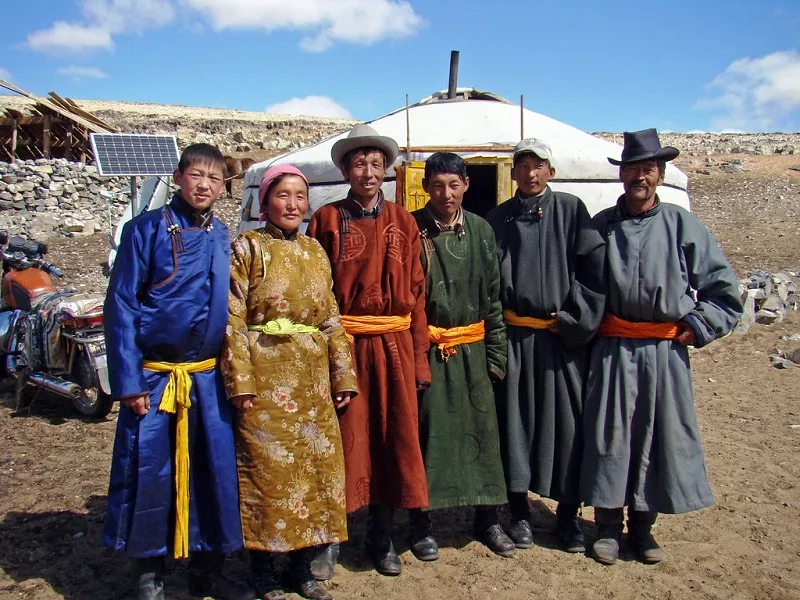In popular media, Mongolians are often depicted as being tall, dark, and bulky, painting a monolithic picture of the Mongolian people. Is this portrayal accurate when we look at contemporary Mongolians? The short answer is no, not exactly. Mongolians display a rich tapestry of physical traits, influenced by their ancestry, given the Mongolian Empire, established in 1206, was a vast confluence of numerous tribes spanning from North Asia to Central/West Asia.
Recognizing Common Mongolian Facial Features
Although each individual is unique, let’s take a look at the commonly shared Mongolian facial features that are often used by foreigners to describe the overall “Mongolian look.”
Prominent High Cheekbones
Perhaps one of the most notable features associated with Mongolians is the presence of high and pronounced cheekbones. Although other Asian groups share this characteristic, it seems to be more prevalent among Siberian groups hailing from Northern and Northeastern Asia.
Stocky Build
While not always the case, Mongolians tend to have a more robust build compared to the average Asian. Factors such as diet and climate play a crucial role in this. A traditional Mongolian nomadic diet, rich in proteins and dairy, contributes to robust bone development. Furthermore, inhabitants of colder climates tend to have bigger bodies to retain heat.
Round Faces
Lastly, it is frequently mentioned that Mongolians often have rounder faces and larger heads. Although the reason behind this is not explicitly clear, public figures such as Miss Mongolia, do exhibit these characteristics to a certain extent.
Red Cheeks
Nomads generally have red cheeks due to extreme weather conditions, from extreme heat to winter blizzards.
Narrow Eyes
Mongolians tend to have long narrow eyes, which is pretty common among Northern Asian people. It’s not exactly almond-shaped like East Asian, although there is overlap of course. Stereotypically, however, Mongolians tend to have eyes similar to the actress who played Borte in the movie Mongol (2007)
Skin Tones among Mongolians: A Spectrum of Diversity
Often, when I travel, people are surprised by my fair skin, as their image of Mongolians is shaped by media portrayals of Mongolian nomads. While a significant number of Mongolians do have tanned and dark skin, there are plenty of Mongolians with pale and fair skin as well. Interestingly, Mongolians generally tan quite easily and are often seen with a healthy glow. Contrary to other East Asian cultures, having a tan is seen as a sign of good health in Mongolian culture.
The 3 Most Common Types of Mongolian Look
Despite the fact that every individual is different, for the sake of understanding, we could categorize the Mongolian look into three stereotypical groups. It might be challenging for foreigners and non-Mongolians to distinguish Asians, let alone a specific ethnic group, but let’s try.
Nomads or People Who Live In Villages/”Soums”

These people, who often live simpler lives, have a unique look. Particularly nomads living in the countryside don’t have access to modern skincare products. As a result, their skin tends to have a rugged appearance. Their constant exposure to the sun also gives them a darker, tanned complexion, often with red, blushed cheeks. However, these features tend to soften once they change their lifestyle.
Urban Mongolians

Mongolians residing in cities generally appear paler, with similarities to Korean and Kazakh people. Urban Mongolians can trace their ancestry back to a variety of regions such as Central Asia, Western Asia, Eastern Europe, Northern China, and Siberia. It’s not uncommon for some city-dwelling Mongolians to have light brown or blondish hair and hazel or green eyes. Unless they have distinctive features, they might often be mistaken for Eastern Asians by most foreigners.
Western/Minority Ethnic Groups in Mongolia
Surprisingly, within the 3 million Mongolian citizens, there are around 20 closely related ethnic groups. From Durvud, Halimag, and Buryat, to the Kazakh people in Bayan Ulgii, and other various ethnic groups in Uvs regions, there’s a mix of East Asian, Central Asian, and Eastern European traits. Given the history of intermarriage and alliances among different Eurasian tribes, it’s not surprising for some Mongolian people to display distinctive Eastern European and Western Asian characteristics. This mix becomes more noticeable the further west you travel in Mongolia.
Final Thoughts
In conclusion, the Mongolian people’s appearance is diverse and far from homogenous, much like their rich and storied history. Every face tells a story of a nomadic past, urban lifestyle, or a blend of Eastern and Western heritage. The differences in their physical traits are a testament to the vast and varied legacy of the Mongolian empire.
Frequently Asked Questions
Why do Mongolians have red cheeks?
It’s due to the harsh weather condition and the dry air that nomads are exposed to on a regular basis. Mongol nomads who are of fair skin tone are susceptible to having red cheeks.
Why do Mongolians have blond, red, or brown hair?
The Eurasian steppes was a mixing pot of different groups of people from Tocharian to Scythians, Western and Eastern nomadic tribes frequently mixed. Some of the genes from thousands of years ago still carry on to modern-day Mongolians. It’s rare for a Mongolian to have fully blond or red hair, but many Mongolians have visible undertones in their hair under the sunlight.
Do Mongolians have green or blue eyes? If so, why?
Yes. Specifically, Mongols from the Western region have mixed with Eurasian people thus it’s not uncommon for some to have green, blue, or grey eyes, though it’s in the minority.
Why do some Mongols look a little Caucasian/White?
Depending on the individual’s ancestry, clan, and tribe, their genetic makeup can vary. Mongols can look quite diverse with some looking northern Chinese, Korean, and Japanese, to a few looking Russian and Persian. Some Mongolians have 5-10% European/Finnic DNA which can be noticeable in people.
Are Mongolians mixed? Do Mongols have Caucasian DNA?
Mongols mixed with various tribes. While most Mongolians look more or less East Asian, some do have higher Western Asian and Finnic DNA that make them look slightly Caucasian such as taller noses, deep-set eyes, lighter hair, eyes, or pale pinkish skin.
How different do Mongols look compared to Chinese?
Generally, Mongols tend to be stockier with rounder faces. The skin tone of Mongols tends to have a reddish, copper undertone. Stereotypically, Mongols look more rugged and rough or with some displaying lighter features. However, the big difference is noticeable in attitude and how Mongols carry themselves. Mongols usually have more flair in their body language.
